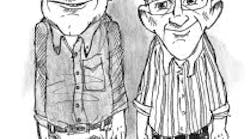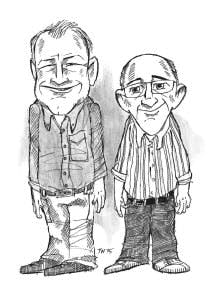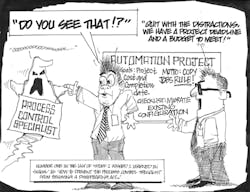Greg McMillan and Stan Weiner bring their wits and more than 80 years of process control experience to bear on your questions, comments and problems. Write to them at controltalk@putman.net. Follow McMillan's Control Talk Blog.
See more Control Talk articles.
Greg: Process control as a profession never gained the recognition it deserved. The situation has deteriorated in my estimation. Based on what I know about the large chemical companies and what the people I am mentoring are doing and facing, the individual is bogged down in executing projects and just keeping systems running. Time for finding opportunities and developing innovative solutions is a rarity.Stan: I don't think plant and corporate management understanding what is missing. A new engineer cannot be expected to change a culture especially if there is no one left to provide an example and understanding of what can be done.
Greg: Since money talks, I think the key is installing online metrics of key performance indicators (KPI) to show the value of what you can do in terms of process performance improvement. A virtual plant can help one understand the problem and find, develop, prototype, test, and demonstrate the solution with "before" and "after" KPI as discussed in the April 2015 Control Talk Column "Getting innovation back into process control."
Do you know who the Top 50 Automation Companies are? Find out.
Stan: The new engineer doesn't know what to look for and how to use the latest tools employed in industry in terms of modeling and control. Greg and I am coming to realize that this needs to start in university courses because we can no longer depend upon this knowledge and even the recognition of the possibilities happening on the job. We need universities to offer courses and ultimately a curriculum and degree in process control. There are examples of universities who have addressed this issue as is the case with McMaster University's Process System Engineering (PSE) degree within the Chemical Engineering Department. To see what other universities have said and were starting to do about 8 years ago, see the InTech October and November 2006 articles "Student to Engineer – Should the Teaching of Process Control be Changed" and "Educating the Engineer – Ready for Industry?"
Greg: I think the consensus is that that frequency response, Laplace Transforms and Z-Transforms should take a back seat to developing an understanding of process control opportunities and solutions in the time domain. While some say it should be eliminated altogether, I take a moderated approach and say two hours should be spent exposing the students to the corresponding frequency response and Laplace Transform as I did when I taught a course on process control in the chemical engineering department of Washington University in Saint Louis when I first retired from Monsanto-Solutia. The open loop and closed loop response should be exemplified for agitated vessel (single volume) operating in the batch and continuous mode, a heat exchanger (distributed volumes) and a PID controller response. I would extend this to show the effect of PID Form and Structure and options such as setpoint lead-lag. One benefit is the realization that a setpoint filter can be set equal to the reset time provides a PID response equivalent to a PID structure of Proportional and Derivative action on process variable and Integral action on error (PD on PV and I on error). Another benefit gained is an understanding in terms of resonance and interaction via a Bode diagram based on frequencies of disturbances and other loops close to the critical frequency of the PID and the tuning causing an amplification or attenuation of the amplitude of the oscillation. I have extensively used the equation in the December 2014 Control Talk Blogs "Measurement Attenuation and Deception Tips" and "Controller Attenuation and Resonance Tips"
Stan: To see what can be done make the most out of a single course in process control and get a current view of what is really needed in terms of additional courses, we talk to Mark Darby who is now teaching the process control at the University of Houston. We did a three part series of columns with Mark Darby on Model Predictive Control (MPC) starting with the "Model Predictive Control - Past Present and Future, Part 1" Mark, what is covered in the typical undergraduate process control course?
Mark: The first thing to mention is that some universities have actually dropped process control as a required course to make room for other courses such as in offerings in the biological area. This is unfortunate for the obvious reasons, namely that this is typically the primary course where students develop an initial understanding of dynamics and learn how common unit operations are controlled. Some of the courses include a lab, others do not. The University of Houston course includes a laboratory exercise. Secondly, the standard undergraduate process control course covers a wide range of topics, covering modeling – basically setting up dynamic balances, solving Ordinary Differential Equations (ODE) with Laplace Transforms, feedback controller design and analysis, feedforward/decoupling design, empirical model identification, interaction analysis, discrete time systems, and an introduction to MPC. In addition, it is now important to include how process safety can be enhanced with control. It can be a challenge in a one semester course to cover all the material. The key is covering the topics in the right amount of detail and emphasizing the salient points.
Greg: I agree that a process control course is critical since the control system is the window into the process and the means of affecting the process. Even if an engineer does not pursue a career in automation, knowledge is needed to get the most out of process control systems. Increasingly the process engineer is being asked to take on the role of the missing process control specialist. Also, smarter and more advanced process control involves putting more process knowledge in the control system. What changes are you going to make to the course?
Mark: I am thinking of starting the course with steady state models illustrating how the equations previously used for design and rating can be used to determine process sensitivities (process gains), the nonlinearity over the operating range, and the controllability or in other words is there sufficient range of a manipulated variable (process input) to control a particular process variable (process output) for expected process conditions and disturbances. I would invert to compute a process input from the desired process output and then make the connection to feedback control. This would then extend naturally to optimizing operating conditions, which is covered later in the course.
Download our beginner's guide to differential pressure level transmitters
Greg: I like the approach of setting up the ODE for energy, material, and component balances including changes of phase and reaction or conversion. I would add the powerful generic charge balance for pH recently extended to include complex conjugate salts. This can be the same starting point for steady state and dynamic models. I put the ODE into a generic form to show the process time constants besides the process gain for various manipulated variables. If you solve for the derivative of the controlled variable and then divide through by variables and parameters that are the multipliers of this controlled variable you have just the derivative of the controlled variable on the left side of the equation. If you set this derivative equal to zero, you have the steady sate equation. If you go back to the original equation with the multiplier of the derivative and do integration by parts, you can end up with a focused ODE that shows what the controller sees in the way of dynamics. If you recognize the generic form for a self-regulating process, integrating process, and runaway process, you can extract concise equations for the process gain and negative and positive feedback process time constants. You can also see how to convert between a self-regulating process gain and time constant and a near integrating process gain. The Virtual Plant that uses the ODE in first principle models and the actual control system configuration and displays is essential for exploring, developing, evaluating, prototyping, and testing process control improvements. The virtual plant also has the dynamics associated sensors, valves, analyzers, wireless transmitters, and various PID options such as external reset feedback. For all of this and more see the online "First Principle Process Relationships," which is Appendix F " from my 2015 Tuning and Control Loop Performance – 4th Edition called a "masterpiece" by Jacques Smuts, an extremely accomplished control system consultant who I have done a Control Talk column and blogs with. The book does represent nearly everything I know about PID control.
Stan: How are you going to utilize your considerable MPC expertise?
Mark: I'm planning to introduce the step response matrix as a way of analyzing a process. The starting point is filling in the directions of the response (sign of gain: + or -) and whether a process relationship is present or not (= blank) and other a priori information that might be derived from first principles - dead time, time constant, and steady state gain. Coverage of the Internal Model Control (IMC) provides a nice tie-in to MPC. At the University of Houston, the MPC part of the course has highlighted linear programming (LP) and quadratic programming (QP) for determining the steady-state optimum.
Stan: What about the PID?
Mark: I emphasize model-based methods, but I don't get carried away with all the various formulas. Important is the linkage between process model parameters and PID tuning parameters, and building in robustness. I mention that lag-dominated processes can be approximated by an integrating model, which ties back into the Ziegler-Nichols (ZN) reaction curve method, although the ZN tuning tends to be too aggressive and lacks robustness. I cover how you tune for load disturbances (disturbances at the process input) and how the use of a setpoint lead-lag eliminates setpoint overshoot when tuning for maximum load disturbance rejection. For integrating level systems, I cover examples where tight level control is appropriate and examples where taking advantage of available tank volume flow to smooth outlet flow is desirable, and emphasize for both situations that the controller gain and integral time need to be adjusted together to ensure an acceptable closed-loop damping factor. I plan to cover integrated absolute error (IAE) as a function of the tuning settings that Shinskey laments is largely missing in the control literature where the focus tends to be on setpoint changes and disturbances on the process output. I cover feedforward, relative gain analysis (RGA) and the one way decoupler, then explain that MPC is the choice for dealing with difficult interactions and feedforwards (e.g., recycle streams) automatically giving dynamic compensation for full decoupling and correction for measured disturbances regardless of complexity.
Greg: Generally missing in the literature is the knowledge that the controller gain obtained from ZN tuning should be reduced by at least 50% to provide more robustness and a smoother response. The ZN settings also assume you exactly know the dynamics and you have compensated for any nonlinearity and are using a setpoint filter equal to the reset time to prevent overshoot for setpoint changes.
I suggest the value of identifying the ultimate period and ultimate gain be conveyed even though you may not use the ultimate oscillation method for tuning. The ultimate period that is the critical frequency useful in determining whether a loop is going to amplify oscillations from batch cycles and on-off actions (e.g. centrifuge and level switch cycles) because the period of these oscillations are close to ultimate period or at best just pass on the variability downstream due the oscillations much faster than the ultimate period. The ultimate gain is also useful as an indicator of the maximum controller gain to determine how large the window of allowable gains is for near-integrating, integrating, and runaway processes. We want the ratio of the ratio of the maximum to minimum controller gain to be about 10 to deal with the inevitable nonlinearities and unknowns as to process dynamics. The minimum controller gain for a proportional plus derivative controller on a runaway process is the inverse of the open loop process gain. The minimum controller gain for a proportional-integral-derivative controller to prevent severe slow oscillations is one half the inverse of the product of the open loop integrating process gain and reset time. See the Emerson Exchange 2015 online paper "Critical Techniques to Prevent Process Instability" for details and a greater understanding of the concept of a minimum PID gain missing in the literature except for some guidelines to prevent the problem for surge tank level control.
The relay oscillation method developed by Karl Astrom provides a robust and rapid identification of the ultimate period and gain if you avoid any pretests and use the right step size. The step size should be 5x larger than the deadband and resolution limit of them manipulated variable. For fast processes, the step size is relatively small (e.g., 2% for a good valve). For slow processes, the step size is relatively large (e.g., 20%) because the change in the process variable is attenuated by the primary time constant or integrating process gain. The oscillations in the process are small and fast crossing back and forth about the setpoint like fast tight on-off control. However, the steps in the PID output can be psychological disturbing. If the factor applied to the ultimate gain to get the PID gain is greatly reduced, the reset time is correspondingly increased to prevent violation of the minimum PID gain limit for near-integrating, integrating, and runaway processes that can be detected as an ultimate period greater than 3.5 times the dead time.
Mark: I will cover the concept of the effect of measurement scale and thus measurement gain and slope of the installed flow characteristic as the valve gain and use this example to introduce valve characterization and more generally static transformations, which are often used in MPC. What should I introduce as being most important in the measurement and valve response?
Greg: Besides minding your Ps and Qs (process variables and quality variables) you need to pay attention to the 5 Rs of measurement and valve response that are rangeability, repeatability, resolution, response time, and reliability". Other performance deficiencies such as drift, offset, span error and nonlinearity can largely be taken care of by calibration, characterization and setpoint changes by an upper loop or an optimizer. Even deadband can be compensated for to some extent by adding a delta equal to the deadband to the change in PID output to jump through the deadband whenever the PID output changes direction by an amount greater than a noise band.
Stan: We commend you for taking the time to help the next generation of control engineers. Teaching a whole course is a large time commitment.
Greg: At my age I am into a much greater time optimization problem. I have a lot of ideas that need to be tested by simulation and documented. See the online version for more on my thoughts including "Stuff I wished I learned in School." Since my stint as a professor about 12 years ago, I have done this by writing 10 very technical books to document and explain what I have recently learned (Good Tuning: A Pocket Guide - 4th Edition, Tuning and Control Loop Performance - 4th Edition, Advances in Reactor Measurement and Control, 101 Tips for a Successful Automation Career, Advanced Temperature Measurement and Control - 2nd Edition, Essentials of Modern Measurements and Final Elements in the Process Industry, New Directions in Bioprocess Modeling and Control, Advanced pH Measurement and Control – 3rd Edition, Models Unleashed, and Advanced Control Unleashed). I have only had time for two funny books, which is my comic relief (The Funnier Side of Retirement for Engineers and People of the Technical Persuasion and Life and Times of an Automation Professional). This comes out to an average of 1 book per year. I am running out of interest and energy besides time. I am thinking the time constraints and money given up by consultants is even greater and that many Technologists and Fellows are nearly fully retired like many of my associates from Monsanto-Solutia including Stan.
Stan: The question is how can we get the most experienced practitioners to teach at universities without interfering with their many other desires and demands? See the online version for Greg's ideas on how to get these people to pass on their industrial application expertise before they leave the scene and his top ten things you don't want to hear in a classroom.
Greg: I propose a curriculum with the following ten courses in process control in the order stated as follows: 1 - Control System Components including PID controllers, measurements, valves and variable frequency drives (VFD), 2 – Batch Sequencing and Safety Instrumented Systems, 3 – Control System Dynamics, 4 – Batch and Continuous Process Dynamics, 5- PID Control Strategies and Online Key Performance Metrics (KPI) for Common Unit Operations, 6 – PID Form, Structure, Anti-Reset Windup, External Reset Feedback, Options, Feedforward, Performance and Tuning, 7 - Synergy of Modeling and Control via a Virtual Plant, 8 Process Analysis, Prediction and Improvement, 9 - Model Predictive Control, 10 – Optimization. ISA Standards will be used to provide details and examples of best practices for courses 1 through 3. ODE will be predominantly used to show the source of process dynamics with an extension by means of the effect of interactive and non-interactive time constants in series for distributed systems (e.g., volumes in series). Hardware labs with actual controllers, measurements, valves, and process equipment will be used to provide physical reality and putting a face on automation components. Virtual plant labs with high fidelity models of the dynamics of automation system components and processes with actual DCS configurations and displays will be used to provide exploration, development, prototyping and testing of new strategies for a wide range of processes.
Stan: How are you going to get key practitioners to teach such an extensive curriculum?
Greg: I propose the course be divvied up into weeks and a person from industry pick what weeks he would want to teach. All the courses would be available online and would consist of 2 hours of lectures per week. Any additional hours per week would be spent in virtual plant labs supported by student assistants who have taken most or all of the courses. The teacher would be given complete freedom as to presentation format and content and types of exercises and test problems with just the requirement to use a common nomenclature and terminology supported by the ISA Dictionary and a Course Addendum. I think many would do one or more of these week sessions for recognition and contribution to the profession. If you look at all the people on Liptak's list who are resources for answering questions, I think there are enough candidates. University professors can teach most of the stuff on Process Dynamics, Model Predictive Control, Optimization, and Multivariate Statistical Process Control.
Top 10 things I wish I’d learned in school
10. The process gain, process deadtime and process time constant depend upon the valve or VFD and measurement besides the process as detailed in the 8/24/2015 Control Talk Blog "Understanding Terminology to Advance Yourself and the Automation Profession"
9. Gains, deadtimes, and time constants are rarely constant. The value of these parameters identified depends upon the operating point and the direction, size and speed of the change in the manipulated variable as discussed in the 10/20/2015 Control Talk Blog "Unexpected Benefits of Signal Characterization" and as detailed for valve, VFD and measurement deadtime on slides in my online 2015 Emerson Exchange Presentation "Critical Techniques to Prevent Process Instability", as seen in the equations for process dynamics in the online "First Principle Process Relationships" and as discussed in the 01/19/2015 Control Talk Blog "Why Tuning Tests are not Repeatable."
8. Deadtime is the ultimate limit to process performance with the peak error proportional to deadtime and the integrated error proportional to the deadtime squared for a step process input disturbance to a perfectly tuned PID controller. Deadtime is easy to measure but difficult to predict.
7. The five R's are the most important and most neglected performance measures for a valves and measurement as detailed in the 09/09/2015 Control Talk Blog "What is Truly Important for Valves and Measurements." The statements of valve and measurement rangeability are out of touch with reality because they do not take into account backlash and stiction near the seat for valves and the effect of noise and resolution (or threshold sensitivity limit) for sensors.
6. On-off valves posing as control valves are a pervasive and continuing threat for the last 4 decades due to lack of understanding and realization that actuator shaft position measured by a smart positioner is often a lie and the deadband from linkages and stick-slip from tight shutoff specs make them a joke as discussed in the October 2007 Chemical Processing article "Improve Control Loop Performance" and the InTech March/April 2010 article "Key design components of final control elements."
5. There are over a hundred tuning rules with each author stating his/hers is the only solution. The real solution is to thoroughly know, modify and exploit your favorite tuning rule as exemplified in the 10/24/2013 Control Talk Blog "Primary Source of Disagreement in Process Control" and in the Control 2014 White Paper "So Many Tuning Rules, so Little Time."
4. The greatest source by far on how knowledge of process dynamics, relationships and objectives can be used to provide the smartest PID control are all of the books by Greg Shinskey that are unfortunately out of print indicating again the lack of understanding and appreciation of improving process control.
3. Nearly all of the articles and books today are not written by users. Process manufacturing companies do not see the value of helping to advance the automation profession and are overly protective of supposed confidential information. I consider Shinskey a user in that he was extensively applying process control and was not trying to sell services or promote a particular automation system.
2. The proper use of PID Form and Structures and options especially "External reset feedback" also known as "dynamic reset limit" that can help prevent oscillations from cascade control, interaction and backlash and provide directional move suppression to prevent unnecessary crossings of the split range point and a gradual optimization with fast protection for abnormal conditions important for surge control and valve position control (noted in the November 2011 Control article "Don't over look PID in APC.")
1. How to detail and communicate "before" and "after" performance metrics and case histories for process control improvements and how to impress corporate executives so that the process control specialist does not become a "disappearing act". How dynamic simulation can be used to help find and document the benefits as discussed in the April 2015 Control Talk Column "Getting Innovation Back into Process Control"
Guide to operator interface - access a compilation of useful articles on this topic







